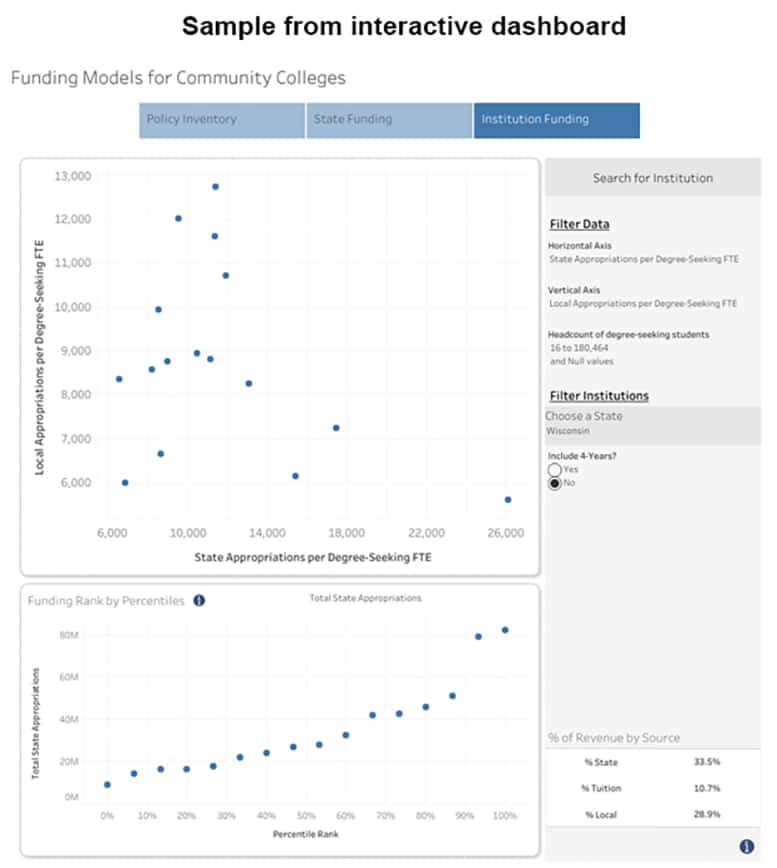Community colleges today serve a wide range of students — from degree-seeking to dual enrollment to noncredit students. However, not all state funding policies have kept up with this reality. A new project from the Association for Community College Trustees (ACCT) and the Student Success Through Applied Research (SSTAR) Lab aims to bring awareness to this issue.
Our team at SSTAR Lab conducted a policy inventory to identify if and how each state funds credit-bearing, dual enrollment and noncredit education activities at community colleges. The resulting report and interactive dashboard are resources community college leaders can use to advocate for a better alignment between funding mechanisms and institutional missions.
Overview of the findings
To identify community college funding policies, we searched state statutes, administrative codes, budgets, legislative documents and other policy documents. We found:
- 50 states fund credit-bearing activities.
- 35 states fund dual enrollment (excluding financial aid and K-12 pass-throughs).
- 27 states fund noncredit education (including workforce training, adult literacy, basic skills, etc.).
- 22 states fund all three enrollment groups.
We also identified the approaches states use to fund different enrollment groups, which included enrollment-based models, performance-based models, institutional requests, special purpose funding, and tuition reimbursements.

Policies in practice
Many states use an enrollment-based funding model, meaning resources are allocated on a per-student or per-credit count. Incorporating different enrollment populations into enrollment-based models can be as simple as ensuring the definition of who “counts” includes dual enrollment and noncredit students.
For example, North Carolina allocates resources to community colleges using a formula based on full-time equivalent (FTE) enrollment. The FTE enrollment count specifically includes credit-bearing students, dual enrollment students, and noncredit continuing education students. Noncredit recreational programs are considered self-supporting and excluded from FTE.
This policy stands out for its inclusive and clear definitions. However, many states do not provide institutions this level of clarity. Without clear policies indicating which student types can be included for funding, institutions may use different measures. This can lead to inequalities.
We find no common definition of noncredit education across — or even within — states. Inconsistent definitions can create confusion when advocating for additional resources. It can also create an unfair funding landscape. For example, the same program could be offered for credit at one institution but noncredit at another. In a state that doesn’t fund noncredit activity, the institution with the noncredit offering would receive less funding.
In addition to increased clarity and consistency, policies should consider how funding can vary to reflect the different needs of each enrollment group. Some states do this by funding each enrollment group separately.
For example, Wisconsin uses a performance-based funding formula where institutions receive resources based on student outcomes. The formula includes (1) a metric for degree attainment, which addresses credit-bearing activities, (2) a metric for participation in dual enrollment, and (3) a metric for the enrollment and success of adult students in basic skills, English language learning, and occupational training, capturing noncredit enrollment.
This approach allows the allocation to vary based on how costs are incurred. For example, some costs are per credit, so FTE is an appropriate basis for the allocation. Other costs are per headcount or at the programmatic level. Separate funding streams allow for this nuance to be addressed.
Funding patterns
As a second component of this project, we used IPEDS data to describe state, local and tuition revenue across states and institutions. Using the resulting interactive dashboard, institutional leaders and policymakers can see the substantial variation in funding levels across and within states. The dashboard also allows users to explore funding over time, the relationship between funding metrics (e.g., state and local appropriations), and how funding ranks compared to other institutions.

“Our analysis also revealed substantial limitations of funding data. Ideally, we could assess the funding levels across different enrollment groups. However, IPEDS data only counts students enrolled in credit-bearing courses. This limits our understanding of per-student funding and our ability to research the effects of funding on dual enrollment and noncredit students.”
Starting a conversation
Our aim is to start a conversation about how state funding to community colleges can reflect the full range of students community colleges serve. In particular, dual-enrollment and noncredit students are often excluded from consideration. We hope this work generates discussion within states on specific funding practices and ways to improve policies. At a higher level, we see trends across states that warrant field-wide discussion.
First, the field would benefit from standard or consistent definitions for these enrollment groups. A lack of clarity may result in unfair funding and can create confusion when advocating for additional resources. Second, data on different enrollment populations is limited, which hinders our understanding of the magnitude of underfunding at colleges serving many non-degree-seeking students.
Finally, this project provides an introductory exploration of funding by enrollment populations, but more research is needed to understand the depth of this issue. Future work should identify if resources are adequate to offer these programs at a high-quality level and should identify the role of local and federal funding for these enrollment groups.
The full report, interactive dashboard and additional materials can be found here.
This work was generously supported by Lumina Foundation.

